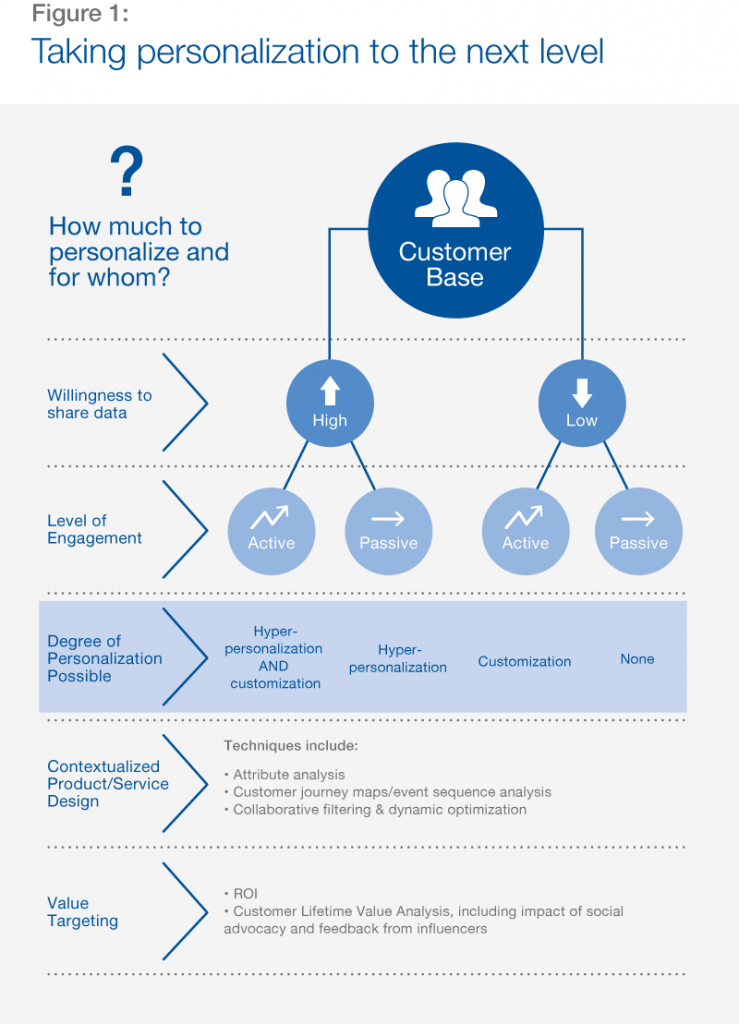Identifying how much personalisation to offer – and to whom – will separate winners from losers.
More than 70% of customers now expect more personalised experiences with the brands they interact with, and digital technology is enabling companies to meet these expectations by delivering personalisation to large numbers of customers at a low cost.
Within this, hyper-personalisation is what is getting everyone excited. Ecommerce companies have for a long time offered users the opportunity to shape or customise products/services, characterised by offerings such as My M&Ms and NikeID. The advent of AI being able to make product selection relevant to the individual and sent at the appropriate time for them, has made it exponentially more successful.
Hyper-personalization is becoming increasingly prevalent, in which customer data is analysed in real time to deliver more relevant interactions. An example of this type of personalisation is Netflix’s Emmy Award-winning engine for generating recommendations, which drives almost 75% of viewing activity on the site.
Customer data and hyper-personalisation
As the possibilities for different types of personalisation – and the specificity with which it can be delivered – increase, companies are facing a new challenge: deciding how much personalisation to offer and to whom.
The first type of personalisation (customers choosing how to customise their products) usually does not require businesses to access significant amounts of customer data and is largely uncontroversial, especially as customers have usually opted to customise their product or service in the first place.
The second type of personalisation (delivering hyper-personalised services, offers or recommendations) relies on regular access to customer data and advanced analytical abilities.
Regular access to customer data is a key requirement for most types of hyper-personalisation but many customers are reluctant to share personal information. However, they reveal a lot more through their impressions and buying history than what they would reveal anyway.
It would be useful to read our article on the distinctions between hyper-personalisation vendors.

2. Draw insights from ‘data’. Different degrees of personalisation used to be defined for different customers, but companies began to appreciate that segmentation is not personalisation.
Instead advanced personalization requires appropriate software to ensure each consumer receives (or sees) what they want, instead of some marketing quadrant they happened to be able to be classed as, female, 30-40, dog-owner, 2.3 kids etc.
Personalisation will need to change from traditional approaches limited to more sophisticated approaches incorporating digital behaviour. Customer data platforms, empowered by AI or machine-learning tools, can help companies address hyper-personalisation in this way at a hyper-personalised level.
Insights can be captured in real-time to feed back into personalised experiences for individuals that are deemed to offer a higher level of return. Companies considering investing in hyper-personalised offers need to understand the degree of hyper-personalisation that would maximise lifetime value for each customer.
3. Identify the right level of personalisation to offer to individual customers. Identifying whether a large part of your customer base is geared toward hyper-personalisation based on their data versus customisation is only part of the challenge.
Understanding and delivering the right level of personalisation to individual customers (and at low cost) is where there is greater differentiation scope for businesses.
Analytical tools have been developed to enable companies to rely on techniques such as attribute analysis to map individual customer attributes based on emotive and psychographic factors; event sequence analysis to map and monetise individual customer journey touchpoints before and after purchase; and collaborative filtering to identify information for decision making based on collaboration among multiple data sources.
The final decision on hyper-personalisation will still have to be based on the company’s assessment of the impact of these initiatives on customer lifetime value, and consequently the return on investment in new software tools and processes.





